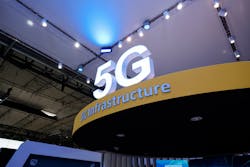Mike's Blog: 5G infrastructure market set to nearly double every year through 2025
Allied Market Research (AMR) is constantly pumping out new market forecast reports, and one of the group's latest contains some eye-popping numbers regarding planting the roots for 5G.
AMR's new report, "Global 5G Infrastructure Market: Opportunities and Forecasts, 2018-2025", states that the worldwide 5G infrastructure market was valued at $371.4 million in 2017. That's not exactly a stunning number, but its future outlook figures are. AMR forecasts that market value to reach a whopping $58.2 billion by 2025, growing at a compound-annual-growth-rate (CAGR) of 95.8% from 2018 to 2025. That's essentially doubling every year over these next seven years.
The potential of 5G technology has been well-documented here on Evaluation Engineering, as it is expected to get the autonomous vehicle market off the ground, enable far superior virtual reality and simulation environments than what is currently available, along with smart infrastructures. These technologies will rely on the enhances connectivity and elimination of latency that 5G is prospected to provide.
"The 5G infrastructure market growth is supplemented by the proliferation of M2M/IoT connections and increase in demand for mobile broadband services," AMR's report said. "However, high investment and technological & infrastructure challenges in implementation of 5G network and privacy & security concerns impede the 5G infrastructure market growth. Furthermore, rise in government initiatives for building smart cities in Asia-Pacific is expected to provide lucrative 5G Infrastructure market opportunity."
In October, the Trump Administration announced a broad outline of its plans to "boost the United States' 5G leadership", leveraging spectrum to provide increased 5G network coverage and efficiency across a variety of applications. Less than four months later, President Donald Trump signed an executive order to accelerate "America's lead in artificial intelligence," with a mission to “focus the resources of the Federal government to develop AI in order to increase our Nation’s prosperity, enhance our national and economic security, and improve quality of life for the American people.”
Here's what AMR had to say specifically about the U.S.' 5G infrastructure market outlook:
"Numerous factors make the 5G era in the U.S. distinctive. For instance, the government institutions of U.S. are continuously making efforts for the progress of 5G with new spectrum allocations and working on the infrastructural deployment. In addition, the U.S. is one of the leading countries in terms of consumer digital engagement and speed of adoption of new technologies. As 4G is still in the current scenario and has been driving the transition from connected to digital consumers, 5G is expected to play a vital role in the transition to the augmented consumer in the long run."
AMR said the 5G infrastructure market size is segmented on the basis of communication infrastructure, network technology, chipset type, application, and region. With that, AMR further breaks down the market as:
- Communication infrastructure: Based on communication infrastructure, it is divided into small cell, macro cell, radio access network, and distributed antenna system. AMR said the small cell segment contributed nearly two-fifths of the total 5G infrastructure market share in 2017, and will maintain its dominance into 2025 due to a surge in demand for mobile broadband services and its ability to efficiently offer high-speed broadband. But, the radio access network segment is expected to have the highest CAGR—108%—during the 2018-2025 period, due to its evolution and support for multiple-input, multiple-output (MIMO) antennas, multi-band carrier aggregation, large spectrum bandwidths, and distributed antenna system.
- Network technology: Based on network technology, it is categorized into software-defined networking & network function virtualization, mobile edge computing, and fog computing.
- Chipset: By chipset, the market is classified into application-specific integrated circuit (ASIC), radio frequency integrated circuit (RFIC), millimeter wave technology chips, and field-programmable gate array (FPGA). Based on chipset type, ASIC held the major share in 2017, accounting for nearly half of the total market share and is expected to maintain its leadership status by 2025 due to an increase in demand for custom chips. However, FPGA is expected to register the highest CAGR—109.6%—from 2018 to 2025 due to its reprogramming characteristics that led to wide adoption.
- Application: Based on application, it is segregated into automotive, energy & utilities, healthcare, retail, and others.
- Region: Based on region, it is analyzed across North America, Europe, Asia-Pacific, and LAMEA. AMR's report said Asia-Pacific accounted for more than one-third of the total share in 2017 and will maintain its dominant position through 2025, owing to huge adoption of smart technologies in the region. However, LAMEA is expected to grow at the highest rate, with a CAGR of 119.4%.
About the Author


